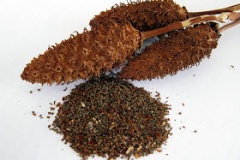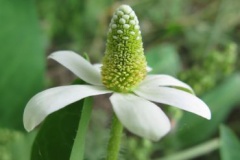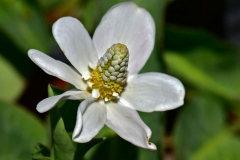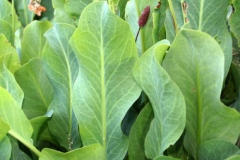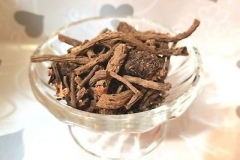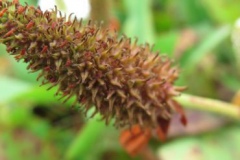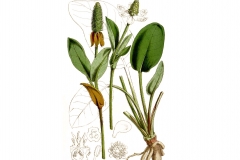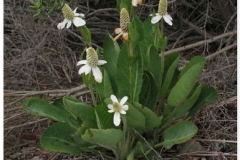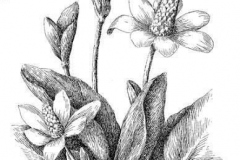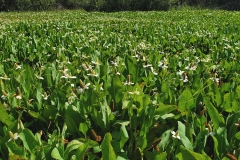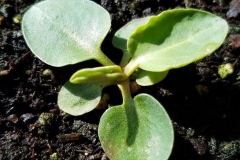| Yerba mansa Quick Facts | |
|---|---|
| Name: | Yerba mansa |
| Scientific Name: | Anemopsis californica |
| Origin | Southwestern North America in northwest Mexico and the Southwestern United States from California to Oklahoma and Texas to Kansas to Oregon |
| Colors | Reddish-brown |
| Shapes | Spiky seedpods |
| Taste | Astringent, acrid |
| Health benefits | Anticancer Properties, Reduce Mucus Production, Digestive problems, Pain Relief, Treat Venereal Diseases |
| Name | Yerba mansa |
|---|---|
| Scientific Name | Anemopsis californica |
| Native | Southwestern North America in northwest Mexico and the Southwestern United States from California to Oklahoma and Texas to Kansas to Oregon and some of the states surrounding it. Mostly, it is found in the states of Arizona, California, Colorado, Kansas, Nebraska, New Mexico and Utah. It is also found in parts of northwestern Mexico. |
| Common Names | Lizard’s Tail, Queue de Lézard, Swamp Root, Yerba Mansa , Anemia California, Yerba Manza, Yerba del Manso, Manso, Bavisa, Raiz del Manso, bear root and Apache beads |
| Name in Other Languages | Chinese: Yè ér bā màn sà (曄洏芭蔓薩) English: Apache-beads, Yerba mansa, Swamp root, lizard’s tail, bear root Spanish: Hierba mansa, Yerba-mansa, Yerba del Manso, Hierba del Mansa, Yerba del Manzo Swedish: Sippsvans |
| Plant Growth Habit | Unique-looking, low growing, stoloniferous, herbaceous, perennial creek side plant |
| Growing Climates | Wet, especially somewhat alkaline or saline marshy places, creeks, damp, boggy areas, and tolerates both salinity and alkalinity |
| Plant Size | Grows to 30cm (1feet) tall and 60cm (2 feet) wide |
| Root | The white roots of this plant are long and threadlike. When young the roots are brittle and become corky and develop bark that covers them when they mature |
| Leaf | Leaf blades measure about 3 to 20 cm (1 to 8 inches) long and are elliptic to oblong, sometimes the base is cordate. The petiole measures 2 to 40 cm (0.7 to 16 inches) long |
| Flowering season |
|
| Flower | Small white flowers that grow on a stem that highlights the leaves at the base. The flowers do not have true petals, but each flower is supported by a 1-3 cm long bract that is white, often tinged reddish. There are around a hundred flowers for each conical shape of the flower head. |
| Fruit Shape & Size | Spiky seedpods |
| Fruit Color | Reddish-brown |
| Taste | Astringent, acrid |
| Plant Parts Used | Bark, roots, seeds and leaves |
| Available Forms | Tea, tincture, extract, infusion, powder, dry capsule, and poultice |
| Health Benefits |
|
| Culinary Uses |
|
Plant Description
Yerba Mansa is a unique-looking, low growing, stoloniferous, herbaceous, perennial creek side plant producing a clump of unbranched stems 8 – 80 cm tall from a stoloniferous rootstock. The plant can spread at the roots and form extensive colonies. The plant normally grows about 30 cm (1feet) tall and 60 cm (2 feet) wide. The plant is found growing in wet, especially somewhat alkaline or saline marshy places, creeks, damp, boggy areas, and tolerates both salinity and alkalinity. It can be found throughout the Western United States living near hot springs, especially if there is alkaline mire nearby. Yerba Mansa needs moist soil, so best to plant in streambeds, seeps or other damp areas. It goes dormant and mostly disappears from late summer to early winter, and re-sprouts from the roots in late winter. The white roots of this plant are long and threadlike. When young the roots are brittle and become corky and develop bark that covers them when they mature.
Leaves
The fleshy, deep green leaves occur as a basal formation. Leaf blades measure about 3 to 20 cm (1 to 8 inches) long and are elliptic to oblong, sometimes the base is cordate. The petiole measures 2 to 40 cm (0.7 to 16 inches) long. Leaves are generally sub sessile to clasping.
The leaves of yerba mansa have a shade of blue and they bear resemblance to those of spinach. However, unlike the spinach, yerba mansa leaves are heavier as well as thicker, while they feel cool and smooth when touched. During the fall, the leaves of this herb develop reddish and black spots and usually they die completely or wither away in winter.
Flowers
In early spring (February to April) numerous tiny white flowers are borne on a cone which is surrounded by 4 to 9 large white spoon-shaped bracts that look like petals. As it matures, the visible part of the plant develops red stains, eventually turning bright red in the fall.
Yerba mansa blooms have snow-white hue with yellow stamens and pistils that are covered in white bracts (petal-like modified leaves). These flowers appear in conical one-inch clusters. The flowers of this low-growing plant usually bloom in spring or the middle of summer.
Fruit
The blooms easily become desiccated producing reddish-brown spiky seedpods that remain on the plants for many months.
Health benefits of Yerba mansa
Listed below are some of the well-known health benefits of Yerba mansa
1. Anticancer Properties
Current research has suggested that water, alcohol, and ethyl acetate extracts of Yerba Mansa (all plant parts, but especially the roots) prevent the growth and migration of certain types of cancer including two breast cancer cell lines, HCT-8, and colon cancer cells. Including it in your daily regimen can be considered quite beneficial.
2. Reduce Mucus Production
Inflammation and a buildup of mucus in the chest can cause unpleasant symptoms like wheezing, sleep difficulties, and a sore throat. Congestion is also often accompanied by a cough that brings up phlegm. Yerba mansa tincture can loosen mucus and reduce congestion and coughing.
Yerba mansa is very soothing and softens the mucous membranes of the throat and especially the lungs and stomach and at the same time cleanses any inflamed mucous membrane that needs immune system support
3. Digestive problems
Digestive issues are so common that everyone experiences them at one point. There are dozens of reasons why you might get a tummy ache, constipation, or gas. Most causes aren’t serious and the symptoms pass quickly. Yerba mansa is a natural inflammatory it is warming and calming to the digestion, anti-nausea, and anti-microbial to many common stomach bugs.
It is a supreme herb for the digestive system, eases stomach cramps and nausea, helps expel gas from the bowel and prevent fermentation in the stomach.
4. Pain Relief
Inflammation is your body’s protective response to injury or damage. It helps your natural healing and repair processes. A problem starts when your body is chronically inflamed.
Yerba mansa has anti-inflammatory properties and is supposed to function as a COX-2 inhibitor in a similar way that some arthritis medications function. It may also help relieve the pain associated with headaches, arthritic inflammation, and toothache
5. Treat Venereal Diseases
Sexually transmitted diseases (STDs) or venereal diseases are transmitted through numerous methods of sexual intercourse (oral, vaginal, and anal). Yerba mansa displays antimicrobial properties against certain bacteria. In general, the antimicrobial effects of this plant are relatively greater on gram-positive bacteria. In some cases, yerba mansa has been recommended in alternative medicine for the treatment of STD’s, with very promising results.
Traditional uses and benefits of Yerba Mansa
- Yerba mansa was extensively used by the native North American Indians to treat a wide variety of complaints.
- Whole plant is analgesic, antiperiodic, and antiphlogistic, blood purifier, disinfectant, diuretic, laxative, stomachic and vulnerary.
- Plant is infused and used to bathe aching muscles and sore feet.
- Root is chewed for affections of the mucous membranes.
- Tea prepared from the root is used as a blood purifier and general pain remedy, and as a treatment for pleurisy, gonorrhea, syphilis and menstrual cramps.
- An infusion of the plant is used in the treatment of colds, chest congestion and stomach ulcers.
- Dried and powdered plant is used as a disinfectant on wounds whilst the fresh moist leaves are used as a poultice or salve on burns, cuts and wounds.
- Yerba mansa was used primarily to disinfect and treat open wounds and sores, as well as to treat colds, coughs, and ulcers.
- Chumash People have traditionally made tea of the root and rhizomes as a wash for wounds and a drink for colds, asthma, urinary disorders, venereal disease, and blood purification.
- Root and rhizome has also been traditionally prepared as a soak for arthritis or venereal diseases.
- It is also used for the treatment of venereal disease, hematuria, pelvic pain, bladder stones, and anuria.
- Pueblo People including the Tewa used a root decoction for stomach ache.
- Isleta use yerba mansa leaves powdered for burns and wounds or chewed fresh and applied as a poultice to burns.
- Shoshone and Washoe Peoples traditionally boil the leaves as a bath for muscular pain and achy feet.
- Mash the decocted roots and apply it as a poultice for swellings or used as an antiseptic wash.
- Root decoction is used for upset stomach, colds, or as a laxative; and root or leaf tea for gonorrhea.
- Papago drank the leaf tea as an emetic and used it in purification rituals for men who had killed an enemy.
- Pima traditionally use it for colds by drinking tea while covered in blankets to increase diaphoresis, as a warm bath for revitalization when fatigued, syphilis wash, and for wound treatments by washing with a decoction or applying powdered roots and then bandaging with a leaf poultice.
- Costanoan People used yerba mansa as a wound wash or powdered root poultice but also prepared root decoctions for menstrual cramps and general pain relief.
- The roots and rhizome of this herb are used to treat and disinfect wounds and sores, for colds, coughs and to cure ulcers since it is anti-bacterial.
- Decoction of Yerba Mansa root is taken internally for Cold, Cough and Menstrual cramps.
- It is used for chronic lung problems, Cystitis and Stomach ache.
- Dried Yerba Mansa roots stepped in water are used to treat Stomach disorders.
- It can be used to treat rheumatic diseases, gout and painful Inflammation of the Joints.
- Cold leaf tea is used as a wash for blisters, insect bites, poison ivy, sunburn and ringworm.
- Poultice of leaves is used to treat sore muscles and aches.
- The herb prevents Kidney stones and prevents the buildup of uric acid crystals in the kidneys.
- Some people in Las Cruces, New Mexico use the leaves to make a poultice to relieve muscle swelling and inflammation.
- Powder of dried root can be sprinkled on infected areas to alleviate athlete’s foot or diaper rash.
- Yerba mansa is used to treat inflammation of the mucous membranes, swollen gums and sore throat.
- Yerba mansa is used as an antimicrobial, an antibacterial, and used to treat vaginal candidiasis.
- Root pounded up and soaked in water; the water is drunk for a bad stomach.
- Tea is taken as a blood purifier; and the plant, in the form of a wash or poultice, is used for rheumatism, while the wilted leaves are said to reduce swellings.
- Root tea was drunk for cough, applied to cuts and sores, or used as a hot bath for rheumatism.
- An infusion made from the bark of the plant was used to wash open sores.
- Bark was boiled into a deep red-wine color, and drunk as a cure for ulcers or applied externally to sores as a wash.
- They also prepared a tea from the root of the herb and used it for washing sores.
- They chewed yerba mansa roots and swallowed them for treating coughs.
- Early settlers from Spain used yerba mansa in the form of an emolument for treating skin complaints.
- They also prepared a tea from the herb’s roots for treating blood disorders.
- Yerba mansa helps to check the development of uric acid crystals inside the kidneys, which, if untreated, may result in kidney stones.
- Tea prepared from yerba mansa roots is used in the form of a douche to treat venereal sores, to check excessive bleeding after childbirth and also to treat uterine cancer.
- Taking a sitz bath with one teaspoon of yerba mansa tincture in about one quart of water facilitates perineum healing following episiotomy or tearing during childbirth.
- The Cahuilla peeled, cut up, squeezed, and boiled the roots into a decoction that was drunk as a cure for pleurisy.
- Moapa Paiute boiled the leaves in a quantity of water and used it as a bath for muscular pains and for sore feet.
Other Facts
- Beads can be made from the rootstock.
- Dried floral structures are used in dried arrangements.
- Dried plant parts (leaves, floral structure) emit a spicy fragrance and are used in potpourri.
- In the deserts of California, yerba mansa is being used as turf in public parks and ground cover in gardens.
Precautions
- Do not use while you are suffering from urinary tract infections.
- Pregnant women and nursing mothers should stay away from this herb, especially from using products made from its roots.
- It has been found that the use of yerba mansa root before any surgical process may result in increased level of sedation.
- Yerba mansa root may also cause drowsiness and sleepiness and, hence, after using the herb or any supplement containing it, one should avoid undertaking tasks that require alertness, such as driving a vehicle or operating any machine.
- Before you start using yerba mansa or supplements prepared from the herb, it is important that you consult your physician or any healthcare professional.
- The herb may cause drug interaction or even cause severe side effects.
References:
https://www.itis.gov/servlet/SingleRpt/SingleRpt?search_topic=TSN&search_value=18223#null
https://npgsweb.ars-grin.gov/gringlobal/taxon/taxonomydetail?id=3410
https://pfaf.org/user/Plant.aspx?LatinName=Anemopsis+californica
https://plants.usda.gov/home/plantProfile?symbol=ANEMO3
http://www.theplantlist.org/tpl1.1/record/kew-2638910
https://en.wikipedia.org/wiki/Anemopsis



